Relationship Between Leadership Style and Patient Safety in Nursing
VerifiedAdded on 2022/10/19
|9
|2224
|28
Essay
AI Summary
This essay delves into the crucial relationship between leadership styles and patient safety within the healthcare setting. It begins by defining leadership and patient safety, emphasizing the significant role nurse leaders play in ensuring patient well-being. The essay then explores the impact of various leadership styles, particularly transformational and laissez-faire approaches, on patient outcomes. Transformational leadership, with its focus on staff empowerment and a positive work environment, is contrasted with laissez-faire leadership, which can potentially hinder patient safety. The analysis extends to medication errors, a common issue, examining how different leadership styles can influence the ability of graduate nurses to provide safe care. The essay concludes by reiterating the importance of adopting appropriate leadership styles to enhance patient safety and improve overall healthcare quality, particularly in the context of managing severe illnesses and supporting graduate nurses. References are included to support the arguments presented.
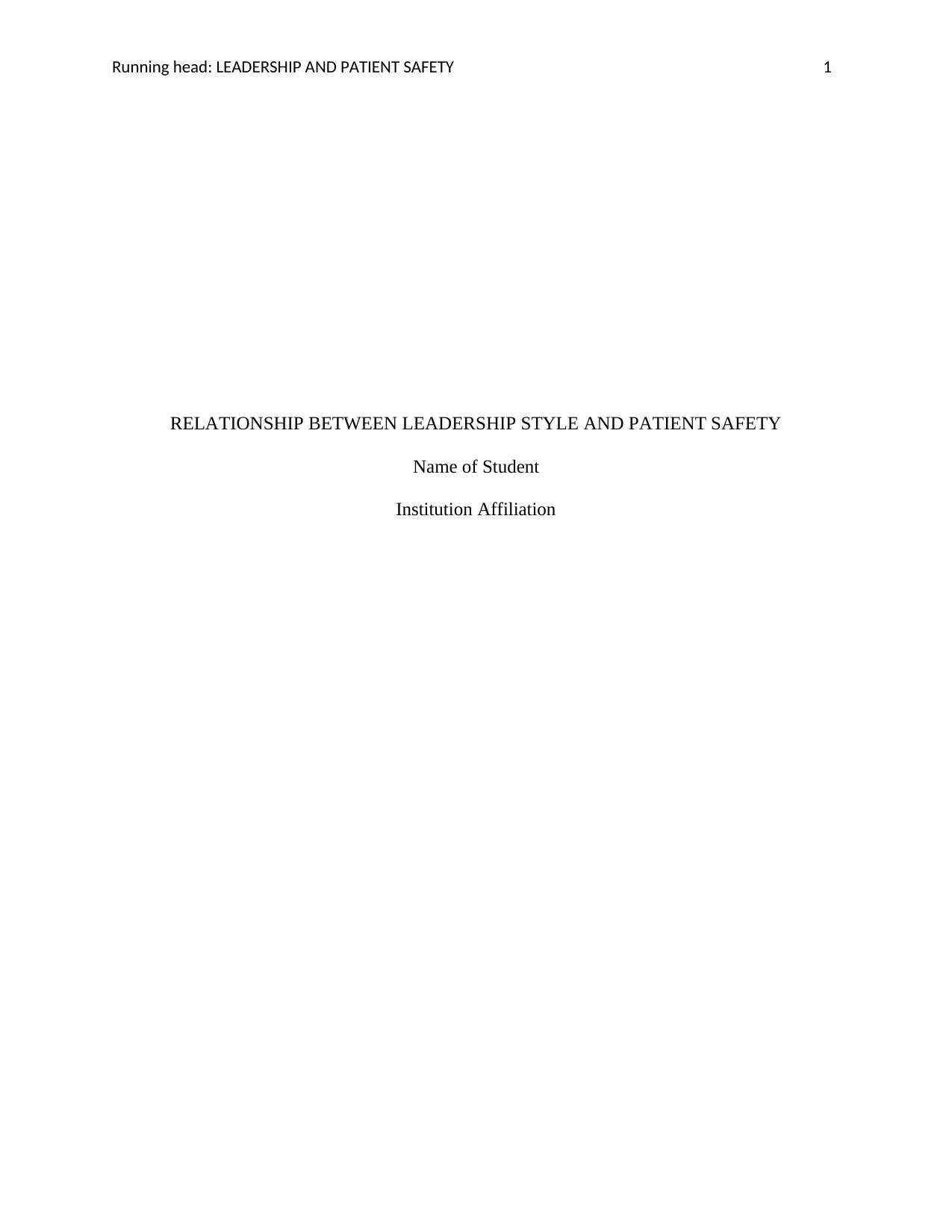
Running head: LEADERSHIP AND PATIENT SAFETY 1
RELATIONSHIP BETWEEN LEADERSHIP STYLE AND PATIENT SAFETY
Name of Student
Institution Affiliation
RELATIONSHIP BETWEEN LEADERSHIP STYLE AND PATIENT SAFETY
Name of Student
Institution Affiliation
Paraphrase This Document
Need a fresh take? Get an instant paraphrase of this document with our AI Paraphraser
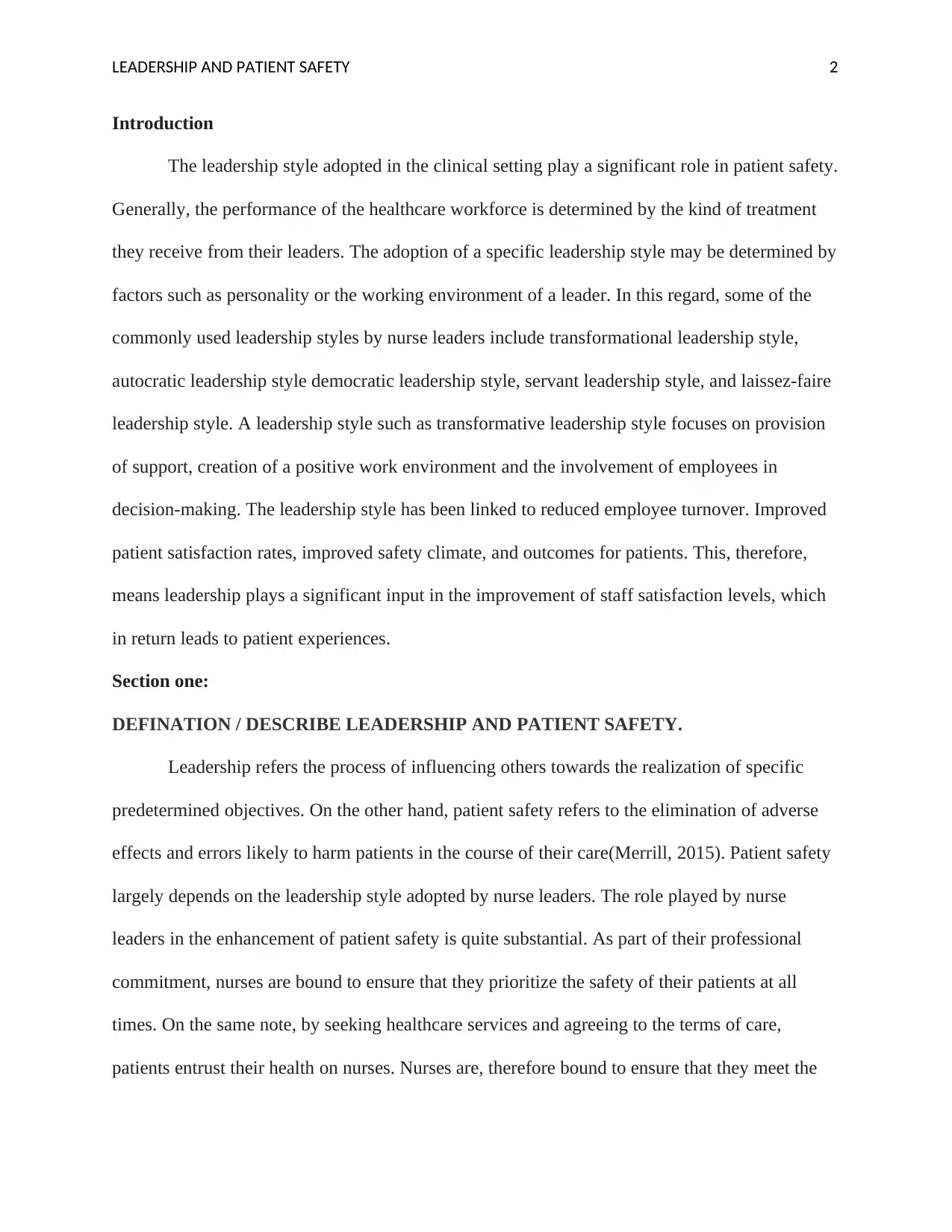
LEADERSHIP AND PATIENT SAFETY 2
Introduction
The leadership style adopted in the clinical setting play a significant role in patient safety.
Generally, the performance of the healthcare workforce is determined by the kind of treatment
they receive from their leaders. The adoption of a specific leadership style may be determined by
factors such as personality or the working environment of a leader. In this regard, some of the
commonly used leadership styles by nurse leaders include transformational leadership style,
autocratic leadership style democratic leadership style, servant leadership style, and laissez-faire
leadership style. A leadership style such as transformative leadership style focuses on provision
of support, creation of a positive work environment and the involvement of employees in
decision-making. The leadership style has been linked to reduced employee turnover. Improved
patient satisfaction rates, improved safety climate, and outcomes for patients. This, therefore,
means leadership plays a significant input in the improvement of staff satisfaction levels, which
in return leads to patient experiences.
Section one:
DEFINATION / DESCRIBE LEADERSHIP AND PATIENT SAFETY.
Leadership refers the process of influencing others towards the realization of specific
predetermined objectives. On the other hand, patient safety refers to the elimination of adverse
effects and errors likely to harm patients in the course of their care(Merrill, 2015). Patient safety
largely depends on the leadership style adopted by nurse leaders. The role played by nurse
leaders in the enhancement of patient safety is quite substantial. As part of their professional
commitment, nurses are bound to ensure that they prioritize the safety of their patients at all
times. On the same note, by seeking healthcare services and agreeing to the terms of care,
patients entrust their health on nurses. Nurses are, therefore bound to ensure that they meet the
Introduction
The leadership style adopted in the clinical setting play a significant role in patient safety.
Generally, the performance of the healthcare workforce is determined by the kind of treatment
they receive from their leaders. The adoption of a specific leadership style may be determined by
factors such as personality or the working environment of a leader. In this regard, some of the
commonly used leadership styles by nurse leaders include transformational leadership style,
autocratic leadership style democratic leadership style, servant leadership style, and laissez-faire
leadership style. A leadership style such as transformative leadership style focuses on provision
of support, creation of a positive work environment and the involvement of employees in
decision-making. The leadership style has been linked to reduced employee turnover. Improved
patient satisfaction rates, improved safety climate, and outcomes for patients. This, therefore,
means leadership plays a significant input in the improvement of staff satisfaction levels, which
in return leads to patient experiences.
Section one:
DEFINATION / DESCRIBE LEADERSHIP AND PATIENT SAFETY.
Leadership refers the process of influencing others towards the realization of specific
predetermined objectives. On the other hand, patient safety refers to the elimination of adverse
effects and errors likely to harm patients in the course of their care(Merrill, 2015). Patient safety
largely depends on the leadership style adopted by nurse leaders. The role played by nurse
leaders in the enhancement of patient safety is quite substantial. As part of their professional
commitment, nurses are bound to ensure that they prioritize the safety of their patients at all
times. On the same note, by seeking healthcare services and agreeing to the terms of care,
patients entrust their health on nurses. Nurses are, therefore bound to ensure that they meet the

LEADERSHIP AND PATIENT SAFETY 3
expectations of patients prioritizing the safety of their patients. They can do this by ensuring that
they provide their staff with necessary support and avail a working environment that makes it
possible for them to maintain safety standards (Ammouri, Tailakh, Muliira, Geethakrishnan & Al
Kindi, 2015).
A DISCUSSION OF THE RELATIONSHIP BETWEEN LEADERSHIP AND PATIENT
SAFETY
The type of leadership style adopted within an organizational setting may, therefore,
promote or hamper the realization of safety outcomes for patients. Scholars have categorized
laissez-faire leadership style as the most dangerous form of leadership in healthcare
organizations. Additionally, the hands-off approach adopted by leaders using his leadership
model has been attributed to the deteriorations of employee satisfaction and patient safety
(Steinhaue, 2016). The leadership style may, therefore, may not promote patient safety. On the
other hand, Transformational leadership has been linked to safety climate in healthcare
organizations (Merrill, 2015).
Transformational leaders are the caliber of leaders in healthcare who can do anything to
keep the operations within their organizations in optimal levels. They are never afraid to try out
what has never been tried or do away with processes or systems that have been used for several
years in exchange of those that have not been tried yet.one of their most distinguishable
characteristics is the role they play in patient safety by acting as patient’s advocates. Their ability
to adapt to new changes in contemporary healthcare settings makes them most suitable in
addressing emergent issues relating to patient safety and quality of care. Transformational
leaders focus on empowering their staff through delegation and improving their ability to
expectations of patients prioritizing the safety of their patients. They can do this by ensuring that
they provide their staff with necessary support and avail a working environment that makes it
possible for them to maintain safety standards (Ammouri, Tailakh, Muliira, Geethakrishnan & Al
Kindi, 2015).
A DISCUSSION OF THE RELATIONSHIP BETWEEN LEADERSHIP AND PATIENT
SAFETY
The type of leadership style adopted within an organizational setting may, therefore,
promote or hamper the realization of safety outcomes for patients. Scholars have categorized
laissez-faire leadership style as the most dangerous form of leadership in healthcare
organizations. Additionally, the hands-off approach adopted by leaders using his leadership
model has been attributed to the deteriorations of employee satisfaction and patient safety
(Steinhaue, 2016). The leadership style may, therefore, may not promote patient safety. On the
other hand, Transformational leadership has been linked to safety climate in healthcare
organizations (Merrill, 2015).
Transformational leaders are the caliber of leaders in healthcare who can do anything to
keep the operations within their organizations in optimal levels. They are never afraid to try out
what has never been tried or do away with processes or systems that have been used for several
years in exchange of those that have not been tried yet.one of their most distinguishable
characteristics is the role they play in patient safety by acting as patient’s advocates. Their ability
to adapt to new changes in contemporary healthcare settings makes them most suitable in
addressing emergent issues relating to patient safety and quality of care. Transformational
leaders focus on empowering their staff through delegation and improving their ability to
⊘ This is a preview!⊘
Do you want full access?
Subscribe today to unlock all pages.

Trusted by 1+ million students worldwide
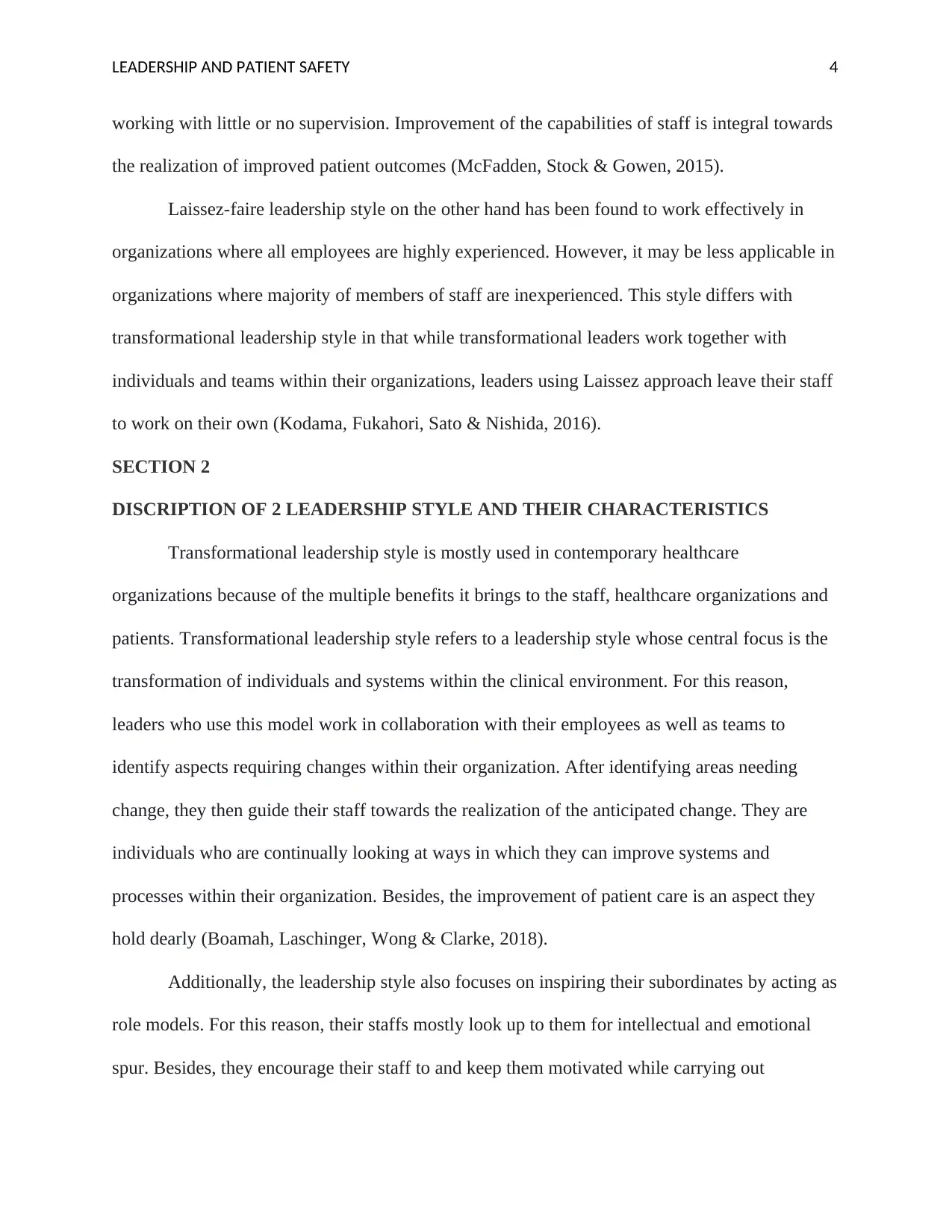
LEADERSHIP AND PATIENT SAFETY 4
working with little or no supervision. Improvement of the capabilities of staff is integral towards
the realization of improved patient outcomes (McFadden, Stock & Gowen, 2015).
Laissez-faire leadership style on the other hand has been found to work effectively in
organizations where all employees are highly experienced. However, it may be less applicable in
organizations where majority of members of staff are inexperienced. This style differs with
transformational leadership style in that while transformational leaders work together with
individuals and teams within their organizations, leaders using Laissez approach leave their staff
to work on their own (Kodama, Fukahori, Sato & Nishida, 2016).
SECTION 2
DISCRIPTION OF 2 LEADERSHIP STYLE AND THEIR CHARACTERISTICS
Transformational leadership style is mostly used in contemporary healthcare
organizations because of the multiple benefits it brings to the staff, healthcare organizations and
patients. Transformational leadership style refers to a leadership style whose central focus is the
transformation of individuals and systems within the clinical environment. For this reason,
leaders who use this model work in collaboration with their employees as well as teams to
identify aspects requiring changes within their organization. After identifying areas needing
change, they then guide their staff towards the realization of the anticipated change. They are
individuals who are continually looking at ways in which they can improve systems and
processes within their organization. Besides, the improvement of patient care is an aspect they
hold dearly (Boamah, Laschinger, Wong & Clarke, 2018).
Additionally, the leadership style also focuses on inspiring their subordinates by acting as
role models. For this reason, their staffs mostly look up to them for intellectual and emotional
spur. Besides, they encourage their staff to and keep them motivated while carrying out
working with little or no supervision. Improvement of the capabilities of staff is integral towards
the realization of improved patient outcomes (McFadden, Stock & Gowen, 2015).
Laissez-faire leadership style on the other hand has been found to work effectively in
organizations where all employees are highly experienced. However, it may be less applicable in
organizations where majority of members of staff are inexperienced. This style differs with
transformational leadership style in that while transformational leaders work together with
individuals and teams within their organizations, leaders using Laissez approach leave their staff
to work on their own (Kodama, Fukahori, Sato & Nishida, 2016).
SECTION 2
DISCRIPTION OF 2 LEADERSHIP STYLE AND THEIR CHARACTERISTICS
Transformational leadership style is mostly used in contemporary healthcare
organizations because of the multiple benefits it brings to the staff, healthcare organizations and
patients. Transformational leadership style refers to a leadership style whose central focus is the
transformation of individuals and systems within the clinical environment. For this reason,
leaders who use this model work in collaboration with their employees as well as teams to
identify aspects requiring changes within their organization. After identifying areas needing
change, they then guide their staff towards the realization of the anticipated change. They are
individuals who are continually looking at ways in which they can improve systems and
processes within their organization. Besides, the improvement of patient care is an aspect they
hold dearly (Boamah, Laschinger, Wong & Clarke, 2018).
Additionally, the leadership style also focuses on inspiring their subordinates by acting as
role models. For this reason, their staffs mostly look up to them for intellectual and emotional
spur. Besides, they encourage their staff to and keep them motivated while carrying out
Paraphrase This Document
Need a fresh take? Get an instant paraphrase of this document with our AI Paraphraser
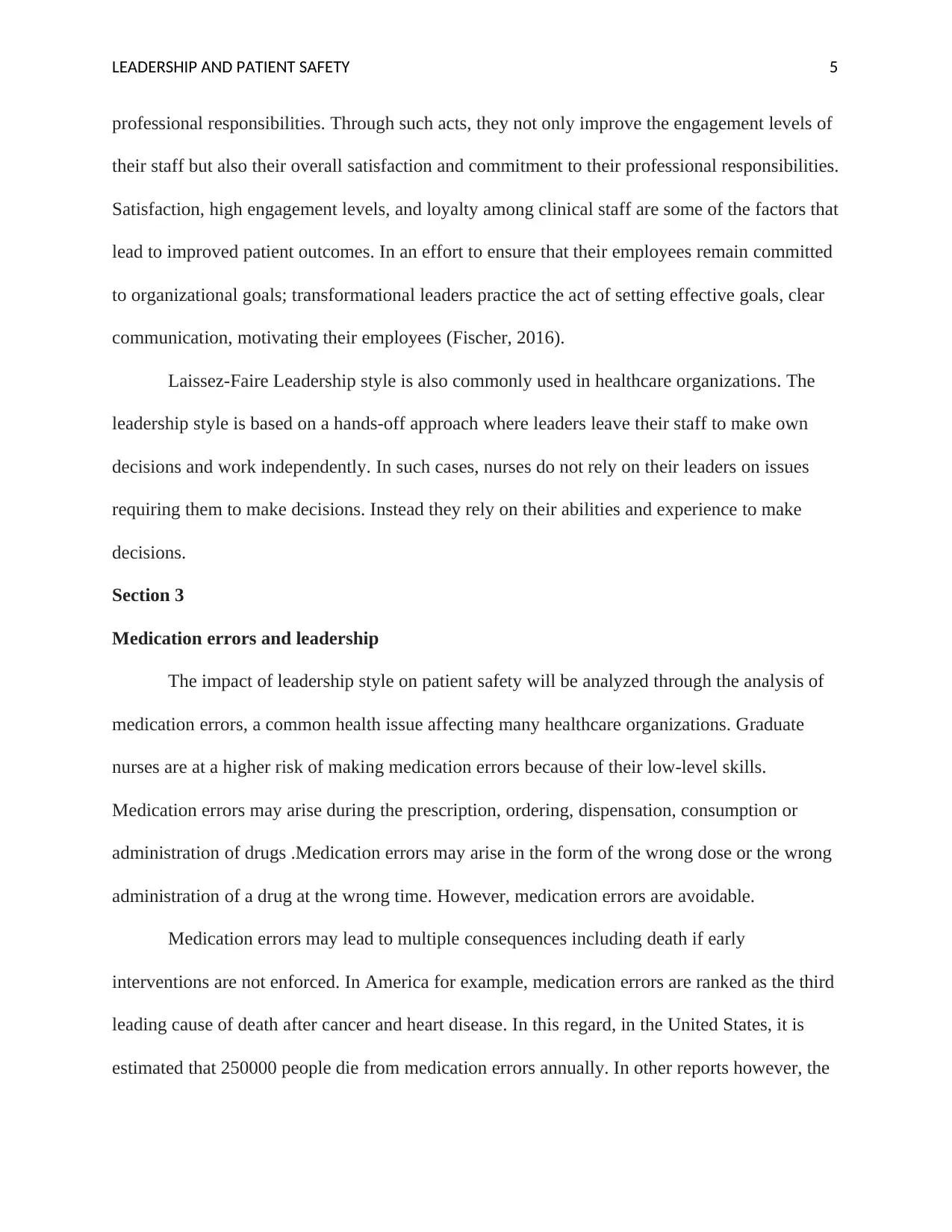
LEADERSHIP AND PATIENT SAFETY 5
professional responsibilities. Through such acts, they not only improve the engagement levels of
their staff but also their overall satisfaction and commitment to their professional responsibilities.
Satisfaction, high engagement levels, and loyalty among clinical staff are some of the factors that
lead to improved patient outcomes. In an effort to ensure that their employees remain committed
to organizational goals; transformational leaders practice the act of setting effective goals, clear
communication, motivating their employees (Fischer, 2016).
Laissez-Faire Leadership style is also commonly used in healthcare organizations. The
leadership style is based on a hands-off approach where leaders leave their staff to make own
decisions and work independently. In such cases, nurses do not rely on their leaders on issues
requiring them to make decisions. Instead they rely on their abilities and experience to make
decisions.
Section 3
Medication errors and leadership
The impact of leadership style on patient safety will be analyzed through the analysis of
medication errors, a common health issue affecting many healthcare organizations. Graduate
nurses are at a higher risk of making medication errors because of their low-level skills.
Medication errors may arise during the prescription, ordering, dispensation, consumption or
administration of drugs .Medication errors may arise in the form of the wrong dose or the wrong
administration of a drug at the wrong time. However, medication errors are avoidable.
Medication errors may lead to multiple consequences including death if early
interventions are not enforced. In America for example, medication errors are ranked as the third
leading cause of death after cancer and heart disease. In this regard, in the United States, it is
estimated that 250000 people die from medication errors annually. In other reports however, the
professional responsibilities. Through such acts, they not only improve the engagement levels of
their staff but also their overall satisfaction and commitment to their professional responsibilities.
Satisfaction, high engagement levels, and loyalty among clinical staff are some of the factors that
lead to improved patient outcomes. In an effort to ensure that their employees remain committed
to organizational goals; transformational leaders practice the act of setting effective goals, clear
communication, motivating their employees (Fischer, 2016).
Laissez-Faire Leadership style is also commonly used in healthcare organizations. The
leadership style is based on a hands-off approach where leaders leave their staff to make own
decisions and work independently. In such cases, nurses do not rely on their leaders on issues
requiring them to make decisions. Instead they rely on their abilities and experience to make
decisions.
Section 3
Medication errors and leadership
The impact of leadership style on patient safety will be analyzed through the analysis of
medication errors, a common health issue affecting many healthcare organizations. Graduate
nurses are at a higher risk of making medication errors because of their low-level skills.
Medication errors may arise during the prescription, ordering, dispensation, consumption or
administration of drugs .Medication errors may arise in the form of the wrong dose or the wrong
administration of a drug at the wrong time. However, medication errors are avoidable.
Medication errors may lead to multiple consequences including death if early
interventions are not enforced. In America for example, medication errors are ranked as the third
leading cause of death after cancer and heart disease. In this regard, in the United States, it is
estimated that 250000 people die from medication errors annually. In other reports however, the
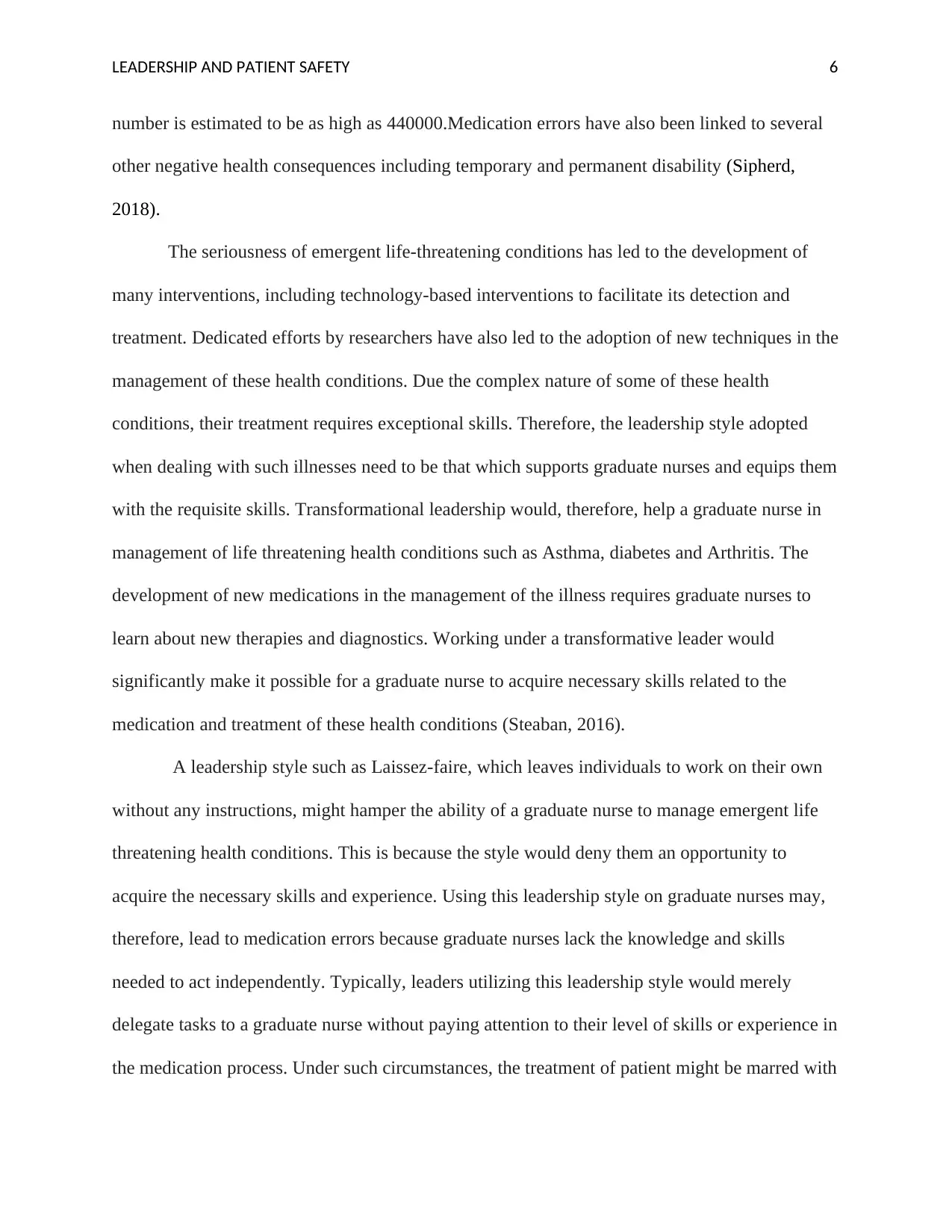
LEADERSHIP AND PATIENT SAFETY 6
number is estimated to be as high as 440000.Medication errors have also been linked to several
other negative health consequences including temporary and permanent disability (Sipherd,
2018).
The seriousness of emergent life-threatening conditions has led to the development of
many interventions, including technology-based interventions to facilitate its detection and
treatment. Dedicated efforts by researchers have also led to the adoption of new techniques in the
management of these health conditions. Due the complex nature of some of these health
conditions, their treatment requires exceptional skills. Therefore, the leadership style adopted
when dealing with such illnesses need to be that which supports graduate nurses and equips them
with the requisite skills. Transformational leadership would, therefore, help a graduate nurse in
management of life threatening health conditions such as Asthma, diabetes and Arthritis. The
development of new medications in the management of the illness requires graduate nurses to
learn about new therapies and diagnostics. Working under a transformative leader would
significantly make it possible for a graduate nurse to acquire necessary skills related to the
medication and treatment of these health conditions (Steaban, 2016).
A leadership style such as Laissez-faire, which leaves individuals to work on their own
without any instructions, might hamper the ability of a graduate nurse to manage emergent life
threatening health conditions. This is because the style would deny them an opportunity to
acquire the necessary skills and experience. Using this leadership style on graduate nurses may,
therefore, lead to medication errors because graduate nurses lack the knowledge and skills
needed to act independently. Typically, leaders utilizing this leadership style would merely
delegate tasks to a graduate nurse without paying attention to their level of skills or experience in
the medication process. Under such circumstances, the treatment of patient might be marred with
number is estimated to be as high as 440000.Medication errors have also been linked to several
other negative health consequences including temporary and permanent disability (Sipherd,
2018).
The seriousness of emergent life-threatening conditions has led to the development of
many interventions, including technology-based interventions to facilitate its detection and
treatment. Dedicated efforts by researchers have also led to the adoption of new techniques in the
management of these health conditions. Due the complex nature of some of these health
conditions, their treatment requires exceptional skills. Therefore, the leadership style adopted
when dealing with such illnesses need to be that which supports graduate nurses and equips them
with the requisite skills. Transformational leadership would, therefore, help a graduate nurse in
management of life threatening health conditions such as Asthma, diabetes and Arthritis. The
development of new medications in the management of the illness requires graduate nurses to
learn about new therapies and diagnostics. Working under a transformative leader would
significantly make it possible for a graduate nurse to acquire necessary skills related to the
medication and treatment of these health conditions (Steaban, 2016).
A leadership style such as Laissez-faire, which leaves individuals to work on their own
without any instructions, might hamper the ability of a graduate nurse to manage emergent life
threatening health conditions. This is because the style would deny them an opportunity to
acquire the necessary skills and experience. Using this leadership style on graduate nurses may,
therefore, lead to medication errors because graduate nurses lack the knowledge and skills
needed to act independently. Typically, leaders utilizing this leadership style would merely
delegate tasks to a graduate nurse without paying attention to their level of skills or experience in
the medication process. Under such circumstances, the treatment of patient might be marred with
⊘ This is a preview!⊘
Do you want full access?
Subscribe today to unlock all pages.

Trusted by 1+ million students worldwide
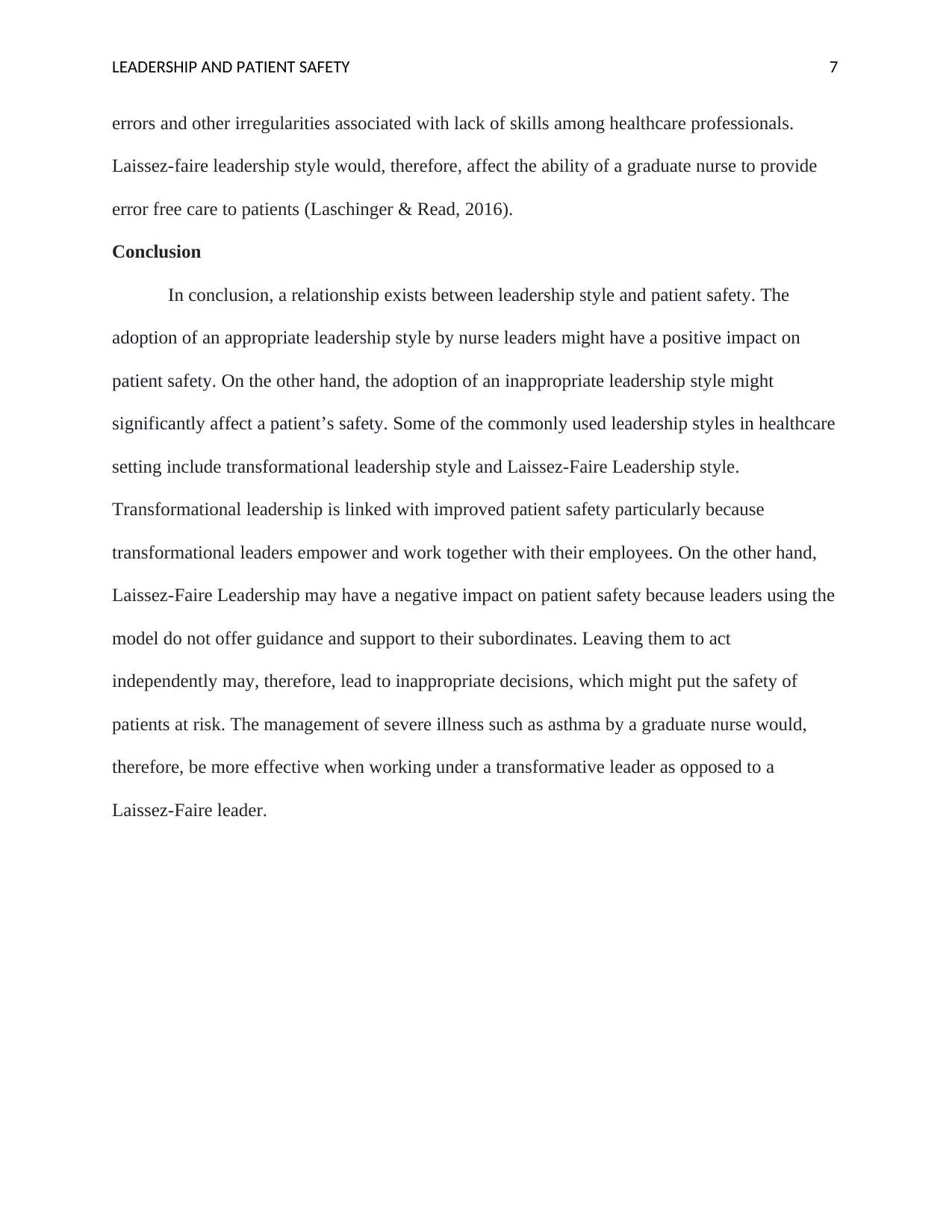
LEADERSHIP AND PATIENT SAFETY 7
errors and other irregularities associated with lack of skills among healthcare professionals.
Laissez-faire leadership style would, therefore, affect the ability of a graduate nurse to provide
error free care to patients (Laschinger & Read, 2016).
Conclusion
In conclusion, a relationship exists between leadership style and patient safety. The
adoption of an appropriate leadership style by nurse leaders might have a positive impact on
patient safety. On the other hand, the adoption of an inappropriate leadership style might
significantly affect a patient’s safety. Some of the commonly used leadership styles in healthcare
setting include transformational leadership style and Laissez-Faire Leadership style.
Transformational leadership is linked with improved patient safety particularly because
transformational leaders empower and work together with their employees. On the other hand,
Laissez-Faire Leadership may have a negative impact on patient safety because leaders using the
model do not offer guidance and support to their subordinates. Leaving them to act
independently may, therefore, lead to inappropriate decisions, which might put the safety of
patients at risk. The management of severe illness such as asthma by a graduate nurse would,
therefore, be more effective when working under a transformative leader as opposed to a
Laissez-Faire leader.
errors and other irregularities associated with lack of skills among healthcare professionals.
Laissez-faire leadership style would, therefore, affect the ability of a graduate nurse to provide
error free care to patients (Laschinger & Read, 2016).
Conclusion
In conclusion, a relationship exists between leadership style and patient safety. The
adoption of an appropriate leadership style by nurse leaders might have a positive impact on
patient safety. On the other hand, the adoption of an inappropriate leadership style might
significantly affect a patient’s safety. Some of the commonly used leadership styles in healthcare
setting include transformational leadership style and Laissez-Faire Leadership style.
Transformational leadership is linked with improved patient safety particularly because
transformational leaders empower and work together with their employees. On the other hand,
Laissez-Faire Leadership may have a negative impact on patient safety because leaders using the
model do not offer guidance and support to their subordinates. Leaving them to act
independently may, therefore, lead to inappropriate decisions, which might put the safety of
patients at risk. The management of severe illness such as asthma by a graduate nurse would,
therefore, be more effective when working under a transformative leader as opposed to a
Laissez-Faire leader.
Paraphrase This Document
Need a fresh take? Get an instant paraphrase of this document with our AI Paraphraser
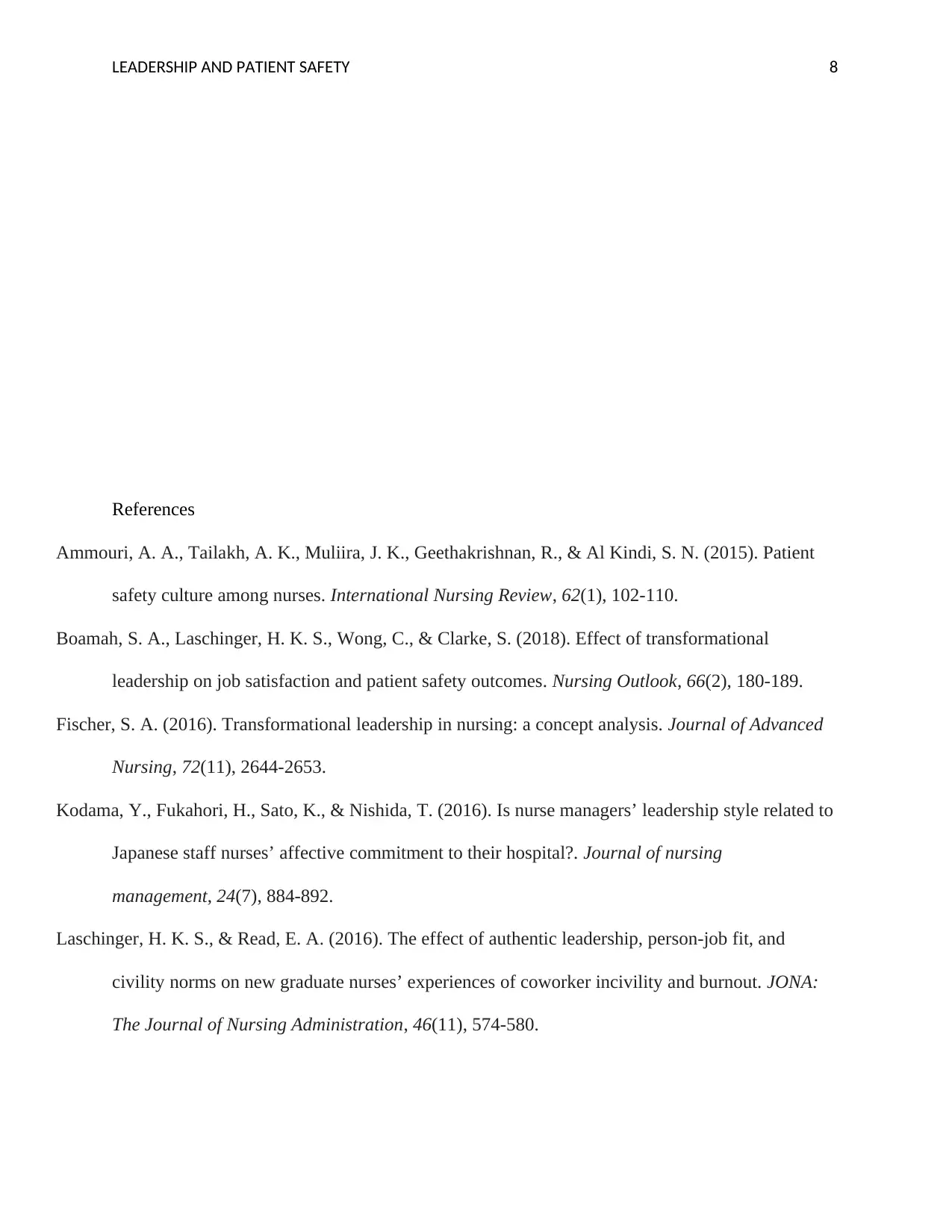
LEADERSHIP AND PATIENT SAFETY 8
References
Ammouri, A. A., Tailakh, A. K., Muliira, J. K., Geethakrishnan, R., & Al Kindi, S. N. (2015). Patient
safety culture among nurses. International Nursing Review, 62(1), 102-110.
Boamah, S. A., Laschinger, H. K. S., Wong, C., & Clarke, S. (2018). Effect of transformational
leadership on job satisfaction and patient safety outcomes. Nursing Outlook, 66(2), 180-189.
Fischer, S. A. (2016). Transformational leadership in nursing: a concept analysis. Journal of Advanced
Nursing, 72(11), 2644-2653.
Kodama, Y., Fukahori, H., Sato, K., & Nishida, T. (2016). Is nurse managers’ leadership style related to
Japanese staff nurses’ affective commitment to their hospital?. Journal of nursing
management, 24(7), 884-892.
Laschinger, H. K. S., & Read, E. A. (2016). The effect of authentic leadership, person-job fit, and
civility norms on new graduate nurses’ experiences of coworker incivility and burnout. JONA:
The Journal of Nursing Administration, 46(11), 574-580.
References
Ammouri, A. A., Tailakh, A. K., Muliira, J. K., Geethakrishnan, R., & Al Kindi, S. N. (2015). Patient
safety culture among nurses. International Nursing Review, 62(1), 102-110.
Boamah, S. A., Laschinger, H. K. S., Wong, C., & Clarke, S. (2018). Effect of transformational
leadership on job satisfaction and patient safety outcomes. Nursing Outlook, 66(2), 180-189.
Fischer, S. A. (2016). Transformational leadership in nursing: a concept analysis. Journal of Advanced
Nursing, 72(11), 2644-2653.
Kodama, Y., Fukahori, H., Sato, K., & Nishida, T. (2016). Is nurse managers’ leadership style related to
Japanese staff nurses’ affective commitment to their hospital?. Journal of nursing
management, 24(7), 884-892.
Laschinger, H. K. S., & Read, E. A. (2016). The effect of authentic leadership, person-job fit, and
civility norms on new graduate nurses’ experiences of coworker incivility and burnout. JONA:
The Journal of Nursing Administration, 46(11), 574-580.
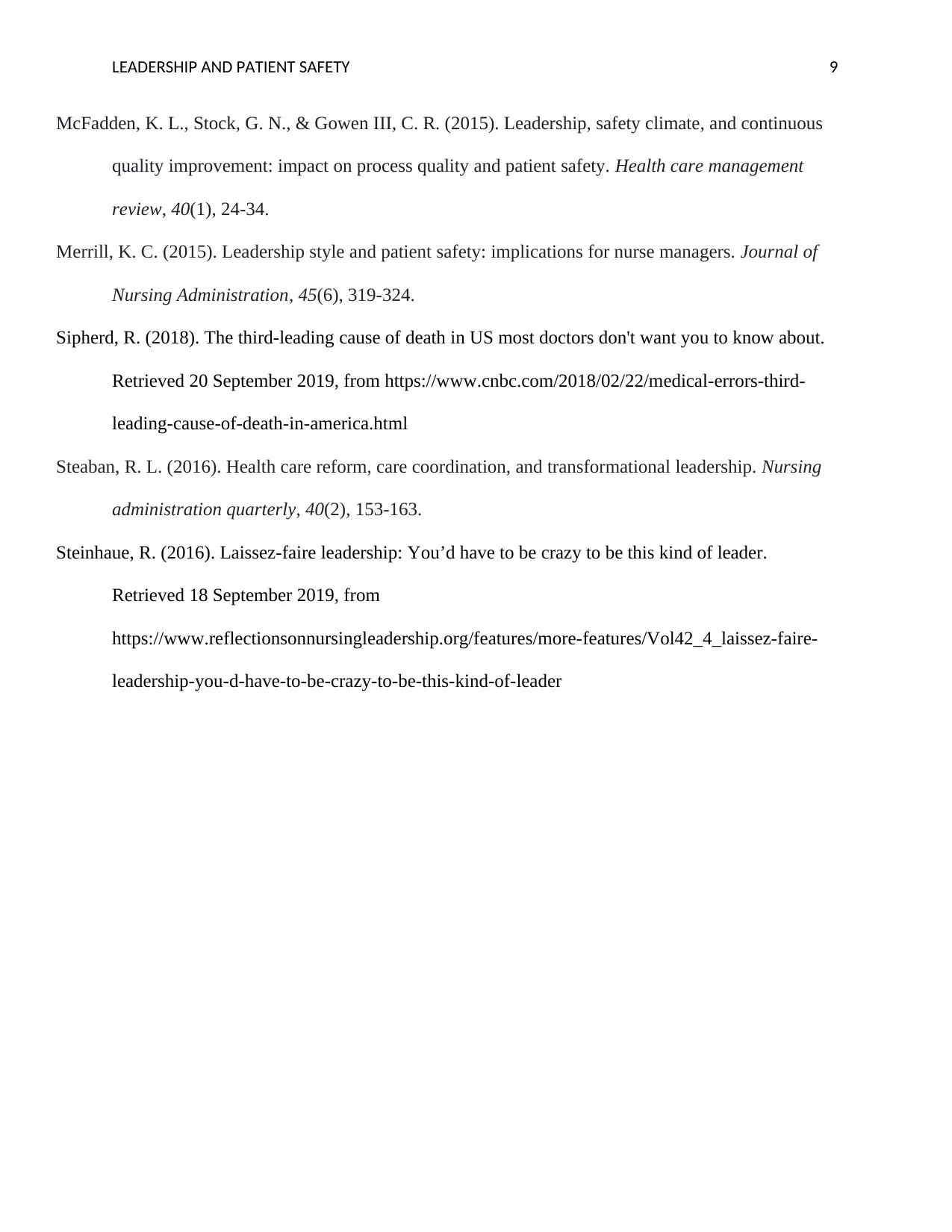
LEADERSHIP AND PATIENT SAFETY 9
McFadden, K. L., Stock, G. N., & Gowen III, C. R. (2015). Leadership, safety climate, and continuous
quality improvement: impact on process quality and patient safety. Health care management
review, 40(1), 24-34.
Merrill, K. C. (2015). Leadership style and patient safety: implications for nurse managers. Journal of
Nursing Administration, 45(6), 319-324.
Sipherd, R. (2018). The third-leading cause of death in US most doctors don't want you to know about.
Retrieved 20 September 2019, from https://www.cnbc.com/2018/02/22/medical-errors-third-
leading-cause-of-death-in-america.html
Steaban, R. L. (2016). Health care reform, care coordination, and transformational leadership. Nursing
administration quarterly, 40(2), 153-163.
Steinhaue, R. (2016). Laissez-faire leadership: You’d have to be crazy to be this kind of leader.
Retrieved 18 September 2019, from
https://www.reflectionsonnursingleadership.org/features/more-features/Vol42_4_laissez-faire-
leadership-you-d-have-to-be-crazy-to-be-this-kind-of-leader
McFadden, K. L., Stock, G. N., & Gowen III, C. R. (2015). Leadership, safety climate, and continuous
quality improvement: impact on process quality and patient safety. Health care management
review, 40(1), 24-34.
Merrill, K. C. (2015). Leadership style and patient safety: implications for nurse managers. Journal of
Nursing Administration, 45(6), 319-324.
Sipherd, R. (2018). The third-leading cause of death in US most doctors don't want you to know about.
Retrieved 20 September 2019, from https://www.cnbc.com/2018/02/22/medical-errors-third-
leading-cause-of-death-in-america.html
Steaban, R. L. (2016). Health care reform, care coordination, and transformational leadership. Nursing
administration quarterly, 40(2), 153-163.
Steinhaue, R. (2016). Laissez-faire leadership: You’d have to be crazy to be this kind of leader.
Retrieved 18 September 2019, from
https://www.reflectionsonnursingleadership.org/features/more-features/Vol42_4_laissez-faire-
leadership-you-d-have-to-be-crazy-to-be-this-kind-of-leader
⊘ This is a preview!⊘
Do you want full access?
Subscribe today to unlock all pages.

Trusted by 1+ million students worldwide
1 out of 9
Related Documents
Your All-in-One AI-Powered Toolkit for Academic Success.
+13062052269
info@desklib.com
Available 24*7 on WhatsApp / Email
![[object Object]](/_next/static/media/star-bottom.7253800d.svg)
Unlock your academic potential
Copyright © 2020–2026 A2Z Services. All Rights Reserved. Developed and managed by ZUCOL.





